Can You Retrain A Dog to Use the Toilet Indoors?

So you’ve housetrained your dog before and Fido’s never had any problems with his potty training — but recently, he seemed to have to forgotten everything. If you’re unsure why this is happening and wondering if it’s possible to teach him the basics once more, this article will be able to shed some light on your questions.
Reasons for urinary & faecal incontinence

Before we dive into the possible reasons for your pooch’s unusual urination and defecation habits, we need to establish that there are different causes for urinary incontinence and faecal incontinence. This is necessary because depending on the cause, the solution to mitigating your dog’s incontinence problem will differ.
Causes of urinary incontinence
- Territorial marking by entire males
- Castration is effective in preventing territorial marking if it’s performed before 6 – 9 months of age. The procedure is less likely to be successful if done at a later age, and behaviour modification may be needed to “unlearn” such marking behaviour.
- Diseases that cause increased thirst or increased urination
- Cognitive dysfunction (aka dementia) in senior dogs
- Mobility issues that prevent the dog from getting up quickly to go to the litter tray or garden eg. Dogs with osteoarthritis
- Spinal cord injury (due to due to trauma or Intervertebral Disc Disease)
- Disruptions to the dog’s regular potty routine
- Behavioural issues eg. boredom or anxiety
Causes of faecal incontinence
- Loss of the rectum’s ability to store faeces
- Loss of control of the anal sphincter
- Cognitive dysfunction (aka dementia) in senior dogs
- Mobility issues that prevent the dog from getting up quickly to go to the litter tray or garden eg. Dogs with osteoarthritis
- Disruptions to the dog’s regular potty routine
- Behavioural issues eg. boredom or anxiety
Determining if retraining is needed
Now that we’re aware of the possible reasons why Fido might be uncharacteristically not paying heed to his potty training, here’s a piece of good news for you — dogs can be retrained at any age!
However, the success for such behavioural modification is dependent on first ruling out non-behavioural causes such as medical conditions and disruptions in the dog’s daily routine. To know if retraining is a viable option for your dog, here’s a foolproof “algorithm”:

Retraining requires plenty of time, patience, and motivation with praise and treats given unsparingly. If needed, seek the help of an animal behaviourist!
Retraining methods

Positive encouragement
Just like how you would reward your pet when attempting to teach him a new trick, the use of praises and rewards will speed up the house-training as your dog will associate it with a positive experience and be more willing to partake in it.
Bear in mind that making mistakes is a normal part of housetraining. Rather than scolding and punishing your pet for it, it is more effective to remain patient and correct their mistakes by bringing them to the correct location. Dishing out scoldings and punishments will only likely scare your dog from relieving themselves in front of you.
To find out more about the use of treats as a reward and motivator in retraining, read our other article here!
Consistency
Keep in mind that house-training is a gradual process where consistency is key, so that you can really drive home the habits that you’re trying to instil in your pooch. If your dog is able to urinate or defecate away from the litter tray at times, it makes it harder for your dog to form the connection that potty time can only be done at the litter tray.
Timing is very crucial to maintain this consistency; you need to guide them to the litter tray right before the deed is done, so keep a close eye on your pet and watch out for signs of it wanting to go.
Use of commands
If your dog is accustomed to listening to a potty cue given before relieving themselves, reinforce the same potty cue while pointing to their designated indoor bathroom spot to get across your message better.

When retraining dogs to relieve themselves indoors, the time needed will definitely differ across all dogs. As a dog owner, the most important factor would be to remain patient and encouraging while following the tips above, and enlist the help of an animal behaviourist if your efforts do not seem to be working. I’m sure that your efforts will be rewarded with an indoor-potty-trained dog once more!
This article was written in consultation with Dr Lennie from The Animal Clinic.









